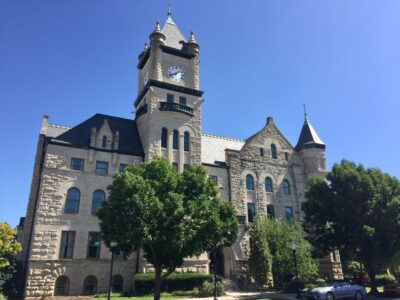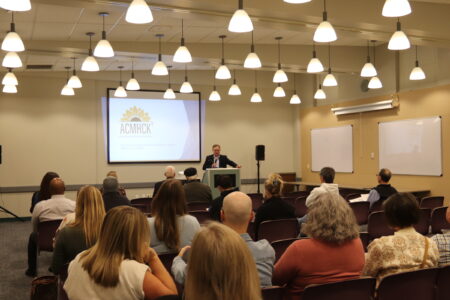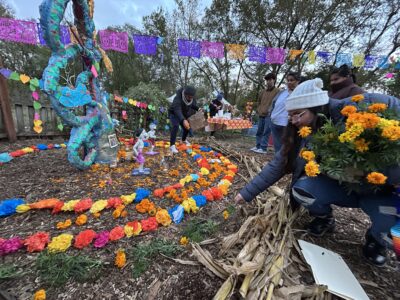Douglas County group hopes ‘data walks,’ exploration of guaranteed income project will lead to lasting solutions to poverty

photo by: Josie Heimsoth/Journal-World
Several people gathered for a "data walk" hosted by hosted by LiveWell Douglas County and the Douglas County Community Foundation on Friday, November 15, 2024.
As they take a deep look at health and poverty in the community, Douglas County officials and community organizations are hoping to get residents engaged in the hard data behind some decidedly hard facts — for example, this fact: In Lawrence, nearly 80% of families living in poverty are headed by single mothers.
The hope is that literally walking people through the evidence, aka “data walks,” will lead to more effective solutions — possibly even a guaranteed income solution — for a host of issues related to poverty.
To that end, health and county officials involved in the Community Health Improvement Plan, or CHIP, recently shared insights on poverty in Douglas County and discussed the potential income initiative to fund basic needs for families.
Aiding this effort is a $10,000 grant from Results for America’s Solutions, an organization dedicated to helping government leaders use data to build more equitable governments and to reduce poverty.
The grant to a cohort of local organizations is funding the data walks – interactive events where community members can engage with, interpret and reflect on data displayed around a room, with a particular focus on poverty. The grant will also help with exploring the potential for a Guaranteed Income Pilot Project – or paying people to help with basic needs – in Douglas County.
As highlighted at a data walk on Friday at the Douglas County Fairgrounds, a few such projects have been implemented across the country, including one in Stockton, California, called the Stockton Economic Empowerment Demonstration, or SEED, which provided 125 randomly selected families with $500 per month for 24 months, spanning both pre-COVID and COVID periods. SEED participants reported that the financial support gave them the resources and time to pursue opportunities like job training, which helped them become more financially secure.

photo by: Douglas County
Families in poverty by type and city in Douglas County.
Another project in Jackson, Mississippi, the Magnolia Mother’s Trust, provides opportunities for Black mothers in federally subsidized housing. The program gives participants $1,000 per month for 12 months. The initiative has increased the number of mothers able to cover basic needs such as food and utility bills while also having funds available for emergencies.
Such projects are informing local discussions about how to help families climb out of poverty.
“We’ve all been working diligently on putting together the data walk series, and we’ll continue to work on the pilot initiative, but part of that is tapping into the lived experience of the population that we want to serve,” Assistant County Administrator Jill Jolicoeur said.
According to the American Community Survey conducted by the U.S. Census Bureau, 1,720 families in Douglas County live in poverty, with 817 of those households led by single mothers with children. In Lawrence, 77.8% of families with children living in poverty are headed by single mothers.
And this isn’t just a local trend. According to the National Women’s Law Center, the official poverty rate for single-mother families was 32%, which is twice as high as the rate of 16.3% for families with children headed by a single man.

photo by: Screenshot
A map of where single, female-headed households are located throughout Douglas County and the population count beyond one mile from a supermarket.
Friday’s walk presented the poverty data fueling the work of the Community Health Improvement Plan, a roadmap for improving the community’s health and wellness outcomes by 2029. The plan is divided up into focus areas, targeting access to health services, poverty reduction, behavioral health, birth outcomes, food security and housing.
Friday’s data walk was hosted by LiveWell Douglas County and the Douglas County Community Foundation, who held award ceremonies and a celebratory breakfast prior to the walk. The data presented at the event gave community members an extensive look into the poverty reduction portion of the CHIP and the chance to ask questions.
Challenges that affect single mothers also affect families living below the ALICE threshold. ALICE stands for Asset Limited, Income Constrained, Employed, referring to households that earn more than the Federal Poverty Level but still fall short of covering the basic cost of living in their county.
Overall, 40% of Douglas County households live below the ALICE threshold, and of those, 64% are single-mother households.
A reason for this number is because the bare-minimum cost of household basics, also known as an ALICE household survival budget, amounts to an annual total of $69,420 for a family with one adult and two children, one preschooler and one infant, in Douglas County. In Kansas, the annual survival budget for this family amounts to $64,800.
But most of these families aren’t making nearly enough to meet basic needs. Discussion leaders reported that the median income for a family with one adult and two children is $66,153, but the living wage needed is $80,345, or $38.63 per hour.

photo by: Douglas County
The Douglas County households over time, including the ALICE threshold. ALICE households earn more than the Federal Poverty Level, but less than the basic cost of living for the county.
In addition, a significant expense is child care. However, presenters at the walk said that the current capacity of child care in the county only meets 46% of the current demand. An estimated 2,841 spots are needed to meet the needs of Douglas County.
Some organizations are looking to provide more of these services. The Community Children’s Center Southwest expects to have 77 new spots for children from infancy to age 5 opening in early 2025. The Early Learning Center in the Eudora school district will open three new classrooms for 3- and 4-year-olds in August 2025.
As the Journal-World reported, the Perry-Lecompton school district also hopes to expand day care options to parents in the school district with 18-month-old to 5-year-old kids after the addition of seven classrooms with restrooms and secured entrances to Lecompton Elementary School.
But there’s still a wage gap for child care workers, as the median income in Lawrence is $26,230, just $410 over the Federal Poverty Level for a family of three.
The team also reported that single-family households occupy about 25% of public housing units and 69% of families receiving housing assistance. The Lawrence-Douglas County Housing Authority estimates that the average wait time to be 18 to 24 months for housing, vouchers and transitional vouchers, which they say is far too long.
“One of the processes we’ve done and will continue to do is work with single female-headed households, who are really navigating poverty in hard ways,” said Suzy Green, Family Resource Center director at the Community Children’s Center.
“Some of the feedback we got from groups so far is how hard it is to see themselves as a number, and I just want you to hold that with you,” Green said.
The Douglas County cohort involved in the data walks includes the Ballard Center, the City of Lawrence, the Community Children’s Center and Douglas County.

photo by: Josie Heimsoth/Journal-World
Assistant County Administrator Jill Jolicoeur discusses Guaranteed Income Pilot Projects with community members on Friday, November 15, 2024.

photo by: Josie Heimsoth/Journal-World
Many people attended a breakfast celebration hosted by LiveWell Douglas County and the Douglas County Community Foundation prior to the “data walk” on Friday, November 15, 2024.







